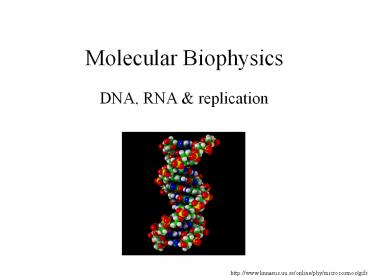Molecular Biophysics - PowerPoint PPT Presentation
Title: Molecular Biophysics
1
Molecular Biophysics
- DNA, RNA replication
http//www.linnaeus.uu.se/online/phy/microcosmos/g
ifs
2
Lennard-Jones Potential
r0 distance parameter
e energy parameter
3
DNA Chemical building blocks Condensation Replica
tion DNP polymerase RNA RNA polymerase rms radius
of random coil
4
Nucleotides
Building units of DNA and RNA
5
DNA and Replication
6
DNA and Replication
Diameter 20Å
3
3
Adjacent bases separation 3.4Å rotated by 36o
5
5
Helical structure repeats after 10
residues (every 34Å)
B-DNA (Watson Crick) 2 grooves 6Å and 12Å deep
packing
7
Why does the DNA double strands not dissociate?
Thermal fluctuations of energy with more 30 kBT
are unlikely. 0.12 aJ _at_ 300K
One hydrogen bond has an energy of 0.005
0.03 aJ p-stacking stabilises double helix
DNA with about 30 base pairs is stabile
However, strands can be taken apart gradually by
enzymes
8
cell division
Replication of 3x109 basepairs Corresponds to
total length of 1m
mitosis
1
2
3
4
5
6
7
8
9
9
Semi-conservative replication
10
DNA and Replication
replication fork
3
Leading strand template
DNA-polymerase d
Newly synthesised strand
Lagging strand template
DNA-helicase
RNA primer
Okazaki fragment
Single-strand DNA-binding protein
DNA primase
5
DNA-polymerase a
11
New strands are always synthesised from their 5
end
12
DNA Polymerase
- Holoenzyme, dimer with 10 subunits
- Adds up to 100 nucleotides / s
- 10 turns of DNA or 34nm
- Moves along DNA
- Recognises wrongly inserted nucleotides and
removes them - instantaneously
- High fidelity error rate lt 10-8 per base pair
http//www.macchess.cornell.edu/MacCHESS_publicati
ons/Steitz_Franklin_01.html
13
DNA helicase
- Unwinds duplex helix
- Uses energy in form of ATP
- Force required to pull strand apart 20pN
- Ploughs through strands with speed of up to 100
nucleotides/s
http//www.hms.harvard.edu/news/releases/1099helic
ase.html
14
DNA and Replication
replication fork
3
Leading strand template
DNA-polymerase d
Newly synthesised strand
Lagging strand template
DNA-helicase
RNA primer
Okazaki fragment
Single-strand DNA-binding protein
DNA primase
5
DNA-polymerase a
15
Transcription and Translation
Synthesis of proteins
Reading information from the DNA
16
RNA (single stranded)
ribose
adenine
uracil
guanine
cytosine
17
RNA Polymerase
Speed 20 nucleotides / s
Error lt 10-4 nucleotides per base
http//www.stanford.edu/group/blocklab/RNAP.html
18
DNA and Replication
The probability P(Ei) that any molecular shape
with energy E is generated by fluctuations is
Z is the partitioning function
Molecular configurations with energy in the order
of kT are common, configurations with higher
energy less common.
19
DNA and Replication
Simple model of 4 monomers
1
1
1
1
Five different configurations or microstates
Suppose we can only distinguish between to
conformational states Compact C and open O
The single compact conformation is stabilised by
the internal energy Uc -e We assume the
internal energy for the open state to be zero, UO
0.
20
DNA and Replication
Calculation of the free energy F for the two
different states
FC UC TSC - e kT ln1 -e
Fo Uo TSo kT ln4
- At low temp the chain is compact owing to the
favourable binding energy, - At high temp the chain is unfolded owing to the
favourable entropy
21
DNA and Replication
At TO e /( k ln4) there is a equal population
of open and collapsed chains. TO represents a
transition between these two populations
- For a transition between open to closed state
- The difference in free energy DF FC(T) FO(T)
-ekT ln4 - The change in internal energy DU -e
- The change in entropy DS -k ln4
22
DNA and Replication
e
Energy of different states
1
1
1
1
e0
1st excited macro state
Breaking the contact between the ends increases
the energy by e0.
1
0
ground state
23
DNA and Replication
Probability of different states
P
Probability of closed state
PO
PC
Probability of open state
T
Of course in a DNA strand or protein there are
more than just one interaction but the principle
is the same

